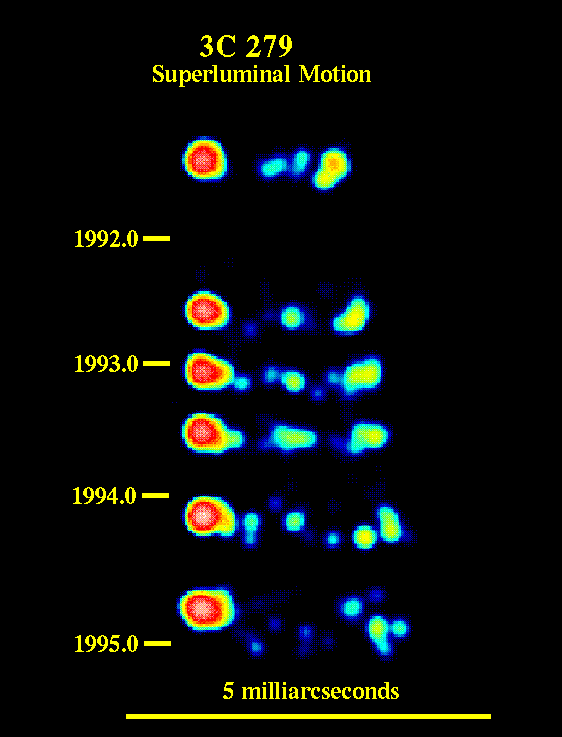
One of the greatest surprises provided by very-long baseline interferometry (VLBI) observations was the fact that some quasars, radio galaxies, and BL Lacertae objects exhibit motion along their jets which works out to several times faster than light. Motion of material at such velocities is forbidden by relativity (which otherwise checks out perfectly, to the chagrin of some diehard science-fiction fans), but relativity also provides a way in which we can see such blobs appear to move faster than light (that is, superluminally). If we see a train of objects moving close to the speed of light and moving almost exactly toward us, tracking the apparent position in our time frame will make them appear to move sideways mush faster than they actually do. And the sources with superluminal motion are typically just those most likely to be pointed toward us - they are bright because of Doppler boosting, and there also seems to be a connection between strong gamma-ray emission and superluminal radio structure. This series of VLBI images, with pseudocolor intensity coding to make the structures easier to see, follows the quasar or blazar 3C 279 over a three-year period. The prominent outer knots are moving with an apparent speed of 4c, typical for superluminal sources.
Just what we are seeing here remains unclear. Some objects show twisted paths for the emerging knots, fitting with theoretical expectations that material may move along helical twists (driven by instabilities in the jets and their imbedded magnetic fields). This montage may show some support for this idea, with complex structure changing raidly between the brightest knots. It is also unclear whether the knots that we see are physical objects, clumps of gas moving together along the jet, or bunchings of material in which the constituent matter constantly changes, as we see in waterfalls and waves.
These images were provided by Ann Wehrle and Steve Unwin, described in a paper in press in the ApJ by Wehrle et al. They have been rotated by 30 degrees to make the jet horizontal, and vertically displaced according to the date of observation. The observations here were taken from 1991- 1994; more recent regular monitoring has been done with the VLBA. The resolution is about 0.2 milliarcsecond, corresponding to about 2 light-years at this distance. These data were obtained at a frequency of 22 GHz (wavelength 1.3 cm).